From
the start of his long career Monet worked mostly in the open air, concentrating
on scenes that he knew well. Wild Poppies was painted at Argenteuil, a pretty
riverside village just outside Paris, where the artist and his family settled
in 1871. Monet loved to paint the boats on the Seine with their sails reflected
in the river's rippling waters like those in The Bridge at Argenteuil.
Such
tranquil, rural scenes contrast strikingly with the crowded streets of Paris
shown in his paintings of the Boulevard des Capucines and the Rue Montorgueil.
But the effects of light and atmosphere gradually became more important to
Monet than the objects in his paintings. In the Gare St-Lazare, for example, it
was the smoke not the train which most fascinated the artist.
In
later life, when Monet moved to Giverny, he developed the unique format of
pictorial series numerous versions of the same view seen under different
lighting conditions. These were designed to be exhibited as a group, and since
each canvas captured a particular instant, together they recorded time passing.
Poplars and Rouen Cathedral each form part of a series, but the most
spectacular of all is the series devoted to Waterlilies. Monet's exotic water
garden was virtually his only subject during the last 20 years of his life,
inspiring some of his most hauntingly beautiful works.
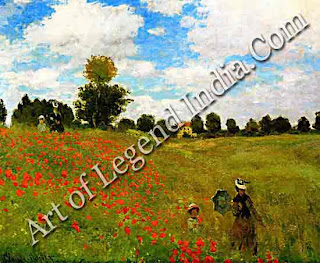 This
little painting of Monet's wife Camille and son Jean walking through a field of
poppies was shown at the first Impressionist exhibition in 1874. Camille and
Jean appear twice in the painting, a device which draws the eye repeatedly to
the triangular hillside of bright red poppies.
This
little painting of Monet's wife Camille and son Jean walking through a field of
poppies was shown at the first Impressionist exhibition in 1874. Camille and
Jean appear twice in the painting, a device which draws the eye repeatedly to
the triangular hillside of bright red poppies.
Monet
may have worked from a photograph when painting this wintry scene. On the
right, a top-hatted figure looks down from a window; below, a dash of pink may
represent a cluster of balloons.
Monet
lived at Argenteuil, near Paris, for seven years and made several paintings of
sailing boats on the Seine. In this tranquil scene, the impression of broken
reflections on the shimmering water is conveyed by well-defined brushstrokes of
pure colour.
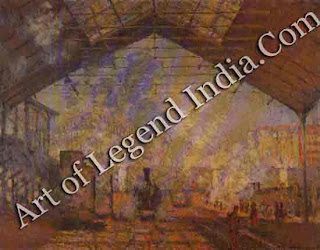 This
railway station was the Paris terminus of the line from Argenteuil and Monet
painted it several times. He captured its atmosphere with clouds of steam and
smoke rising from the engine, and shadows thrown by the glass roof rather than
a precise, detailed likeness.
This
railway station was the Paris terminus of the line from Argenteuil and Monet
painted it several times. He captured its atmosphere with clouds of steam and
smoke rising from the engine, and shadows thrown by the glass roof rather than
a precise, detailed likeness.
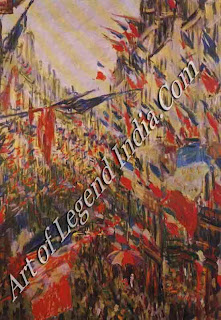 This bird's-eye view of a Parisian street, decked out in celebration of a national
holiday, was painted rapidly on a balcony overlooking the scene. The red, white
and blue stripes of the French flags form vibrant patches of colour, and in the
centre of the picture a slogan in blue reads 'Vive la France'.
This bird's-eye view of a Parisian street, decked out in celebration of a national
holiday, was painted rapidly on a balcony overlooking the scene. The red, white
and blue stripes of the French flags form vibrant patches of colour, and in the
centre of the picture a slogan in blue reads 'Vive la France'.
A row
of tall poplars lining the River Epte near Monet's home in Giverny fascinated
the artist, and he painted them many times from his boat. In this late stage of
his career Monet's Impressionist style grew increasingly abstract and
decorative.
Like
Poplars, this painting formed part of a series: Monet painted the same view
over and over again, under changing light conditions. The year after this
version was completed, 20 different canvases were exhibited together, covering
the whole day from dawn to dusk.
Art
Museum, Missouri
Monet
painted the waterlily pond at the bottom of his garden hundreds of times: it
became virtually his only 'model' for the last 20 years of his life. He focused
increasingly on this small area, painting ever larger pictures. This 14-foot
long canvas was originally the central panel of three, forming a massive
40-foot painting. The lilies themselves are not immediately recognizable they
dissolve into a magical mixture of delicate colours.
Writer - Marshall Cavendish
 This
little painting of Monet's wife Camille and son Jean walking through a field of
poppies was shown at the first Impressionist exhibition in 1874. Camille and
Jean appear twice in the painting, a device which draws the eye repeatedly to
the triangular hillside of bright red poppies.
This
little painting of Monet's wife Camille and son Jean walking through a field of
poppies was shown at the first Impressionist exhibition in 1874. Camille and
Jean appear twice in the painting, a device which draws the eye repeatedly to
the triangular hillside of bright red poppies. This
railway station was the Paris terminus of the line from Argenteuil and Monet
painted it several times. He captured its atmosphere with clouds of steam and
smoke rising from the engine, and shadows thrown by the glass roof rather than
a precise, detailed likeness.
This
railway station was the Paris terminus of the line from Argenteuil and Monet
painted it several times. He captured its atmosphere with clouds of steam and
smoke rising from the engine, and shadows thrown by the glass roof rather than
a precise, detailed likeness.  This bird's-eye view of a Parisian street, decked out in celebration of a national
holiday, was painted rapidly on a balcony overlooking the scene. The red, white
and blue stripes of the French flags form vibrant patches of colour, and in the
centre of the picture a slogan in blue reads 'Vive la France'.
This bird's-eye view of a Parisian street, decked out in celebration of a national
holiday, was painted rapidly on a balcony overlooking the scene. The red, white
and blue stripes of the French flags form vibrant patches of colour, and in the
centre of the picture a slogan in blue reads 'Vive la France'.
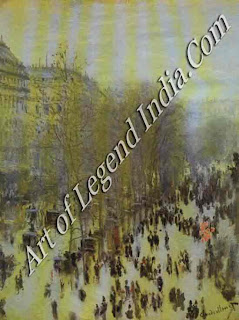
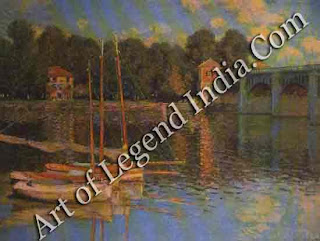

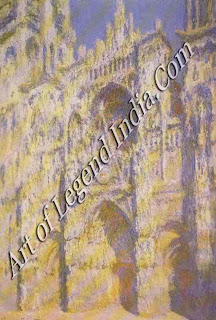
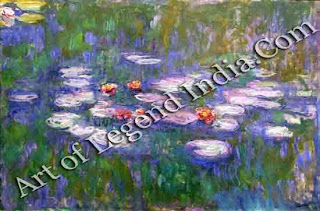










0 Response to "French Great Artist - Claude Monet Painting Gallery"
Post a Comment